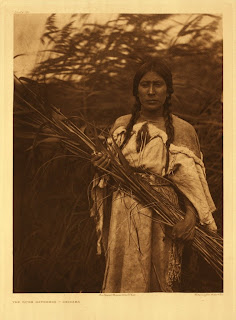
Beautiful, I love the close up. the deep lines of his face and the look of almost boredom the wisdom of his face is captured wonderfully in this picture.

These are the men in the tribe, the provider and protectors of the tribe. the look on there face is different then the women. Still capturingthe honesty but lso a more weathered and srong look.

Another truly honest open picture. There is no hidden features with these two women. they have open faces. And look so wise and calm.

This is My favorite, this was the first pic. he ever took of a Native American.It is called Princess Angeline. when someone says Princess you think of delicate and beautiful and kind. She is a princess in her own way.

I really love this picture. I am soft for pictures of Native Americans, I don't know why. there faces always reflect a light of knowledge and wisdom. I love the moment she was caught in, doing the daily chores.
Ed was born in Whitewater, Wisconsin. In 1874 moved from Wisconsin to Minnesota. Where a young Curtis built his own camera. At seventeen he was apprenticed to a photographer in Minnesota. His family moved again. In 1892 he married Clara J. Phillips. Had four kids with Clara. In 1896 he and his family (consisting of numerous brothers and sisters of Clara and him) moved to Seattle. In 1910 Clara divorced him and his entire studio went to her. With the help of his daughter (Beth) he trashed all of his pictures, rather having them destroyed instead of left with his ex-wife. Clara then operated the studio with a daughter named Katherine. 1922 Ed moved to LA with his daughter Beth opening a new studio and working for a movie director. Soon after he was arrested for failing to pay alimony, but he got out of charges. In 1932 Clara (still operating his old studio) died while rowing in Pungent Sound. Katherine moved to be closer to her sister and Father. Edward at age 84 of a heart attack he is buried in Forest Lawn Memorial Park.
Edward Curtis first photographed a native American in 1895. Her name was Angeline.
the print was called Princess Angeline. Soon afterwords he was invited on a expedition by George Grinnell to photograph the Blackfoot Indians. 1906 he was offered mucho money to photograph a series of native americans, 20 volumes, 1,500 photos. He dove into this project, not only taking pictures but documenting native amaericans life, wrote sketches of the chiefs life. His detailed study of native amaericans is still with us today. In 1922 he worked on a movie called Land of the Head-Hunters.




